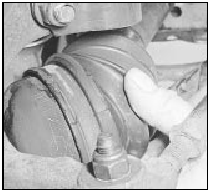Driveshaft check (Every 12 000 miles or 12 months)
1 Carry out a thorough inspection of the driveshafts and joints as follows.
2 Jack up the front of the car and support it securely on axle stands (see “Jacking and Vehicle Support”).
3 Slowly rotate the roadwheel and inspect the condition of the outer joint rubber bellows.
Check for signs of cracking, splits or deterioration of the rubber which may allow the grease to escape and lead to water and grit entry into the joint (see illustration). Also check the security and condition of the retaining clips. Repeat these checks on the inner constant velocity joints. If any damage or deterioration is found, the bellows should be renewed as described in Chapter 8.

29.3 Checking driveshaft outer joint rubber bellows
4 Continue rotating the roadwheel and check for any distortion or damage to the driveshaft.
Check for any free play in the joints by first holding the driveshaft and attempting to rotate the wheel. Repeat this check by holding the inner joint and attempting to rotate the driveshaft. Any appreciable movement indicates wear in the joints, wear in the driveshaft splines or loose retaining nut.
5 Road test the car and listen for a metallic clicking from the front as the car is driven slowly in a circle with the steering on full lock.
If a clicking noise is heard this indicates wear in the outer constant velocity joint caused by excessive clearance between the balls in the joint and the recesses in which they operate.
Remove and inspect the joint (Chapter 8).
6 If vibration, consistent with road speed, is felt through the car when accelerating, there is a possibility of wear in the inner constant velocity joint. If so, renewal of the driveshaft inner joint will be necessary.
See also:
Internal connection details, all models
Internal connection details, all models ...
Pistons and connecting rods - examination and renovation
1.8 litre (R2A type)
1 Examine the pistons for ovality, scoring,
and scratches. Check the connecting rods for
wear or damage.
2 The gudgeon pins are an interference fit in
the connecting rods, an ...
Tailgate wiper motor - removal and refitting
Removal
1 Disconnect the battery and remove the
wiper arm/blade assembly.
2 Remove the pivot shaft nut, spacer and
outer seals.
3 Open the tailgate and remove the trim panel
(refer to Chapter 11 ...
